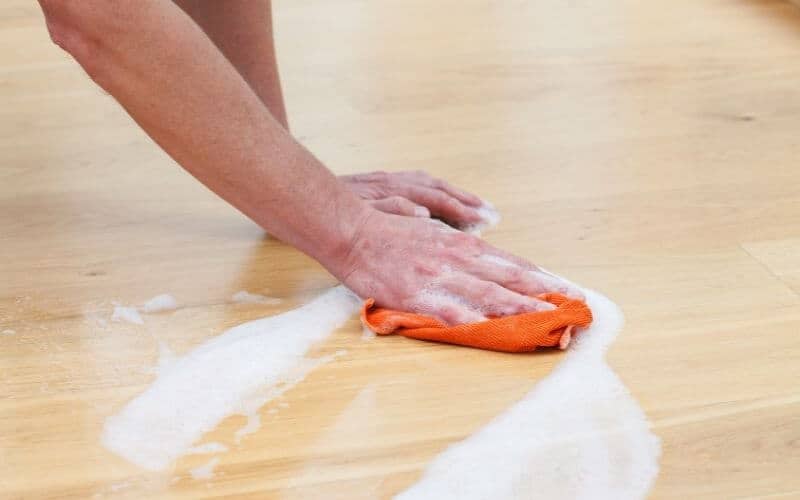Picture this: a sunny Saturday afternoon, you’re painting your living room a beautiful shade of blue. You’re feeling confident, the music is playing, you even have a dropcloth down – but somehow, a few rogue paint drops find their way to your hardwood floor. You sigh, knowing you’ll have to deal with it later. Now, the paint is dry. Panic sets in. Can you salvage your beloved hardwood floors?

Image: www.youtube.com
Don’t worry, friend. It’s a common problem, and there’s a good chance you can remove the paint without causing any lasting damage. With the right tools and a little patience, your hardwood floors can be restored to their former glory. Let’s dive into the best ways to remove dried paint from hardwood floors.
Assessing the Damage and Choosing Your Weapon
The first step is to determine the type of paint you’re dealing with. Latex paint is water-based and generally easier to remove than oil-based paint, which is more durable and requires a slightly different approach.
Here’s a quick way to figure out what you’re working with:
- Latex Paint: If the paint is shiny and feels slightly sticky, it’s likely latex.
- Oil-Based Paint: If the paint has a more matte finish and feels dry and brittle, it’s likely oil-based.
Once you’ve identified the type of paint, you can select the most effective removal method.
The Gentle Approach: Using a Paint Scraper
For latex paint, a gentle approach is often the best way to go. You can start with a plastic paint scraper, which is less likely to scratch the wood. Hold the scraper at a 45-degree angle and gently pry at the paint, working in small sections. Be careful not to press too hard, as this could damage the wood. You can also consider using a rubber spatula or even a credit card for a less aggressive approach.
The Power of Patience (and a Heat Gun)
If the paint is more stubborn, you might need to heat it up to soften it. A heat gun can be a valuable tool for this task, but use it with caution. The heat can be intense and could potentially cause damage if not used properly.
Here’s how to use a heat gun safely and effectively:
- Work in a well-ventilated area: The heat gun produces fumes, so it’s essential to work in a space with plenty of fresh air.
- Test the heat on an inconspicuous spot: Start with a low heat setting and gradually increase it if needed. Test on a hidden area of your flooring to ensure the heat doesn’t damage the finish.
- Move the gun across the surface: Don’t hold the heat gun in one place for too long as this can scorch the wood. Keep the gun moving gently over the paint until it starts to soften.
- Use a scraper immediately: Once the paint softens, use your plastic scraper to gently remove it.
Important Note: Always wear protective gloves and eye goggles when using a heat gun, and be extremely cautious to avoid burning yourself.

Image: floorcarekits.com
For the Stubborn Patches: Chemical Solutions
If the paint still refuses to budge, you might have to turn to a chemical solution. However, this should be a last resort as chemicals can be harsh on hardwood floors and require careful handling.
Here’s a breakdown of the most common chemical options for paint removal:
- Mineral Spirits: This is effective for removing oil-based paint but can be very flammable. Use it in a well-ventilated area and avoid contact with your skin.
- Paint Thinner: This is another option for oil-based paint, but it can also damage the wood’s finish if not used carefully.
- Commercial Paint Remover: Look for a remover specifically designed for hardwood floors. Follow the instructions on the product label carefully.
Important Note: Always test any chemical solution on a small, inconspicuous area of your floor first. This will help you check for any reactions or damage before applying it to the entire affected area.
Restoring Your Floors to Their Original Glory
Once you’ve removed the paint, it’s essential to clean the affected area thoroughly. Use a damp cloth with a mild cleaning solution to remove any remaining paint, solvents, or debris. Dry the floor completely before applying any finish.
If the paint removal process has affected the finish of your floor, you may need to re-apply a sealant or stain.
Pro Tip: If the paint removal has gone exceptionally well and you’re happy with your work, consider using a sealant to protect your hardwood floors from future spills and stains. This will help preserve their beauty and increase their lifespan.
Expert Advice: When to Call in the Pros
While most paint removal projects can be tackled by a determined DIYer, there are cases where it’s best to call in a professional. If:
- The paint is extensive or layered thick.
- You’re unsure about the type of paint used.
- You’re worried about damaging the finish of your floors.
A professional floor refinisher will be best equipped to handle these situations, ensuring your floors are restored to their original beauty without any costly mistakes.
Best Way To Remove Dried Paint From Hardwood Floors
The Takeaway: Your Floors Deserve a Second Chance
Removing paint from hardwood floors can be a daunting task, but with the right tools, techniques, and a bit of patience, it’s a challenge that can be overcome. Remember to prioritize safety, follow the advice of the experts, and enjoy the satisfaction of restoring your beautiful hardwood floors to their glory.
Now, go get that paint off your floors!






